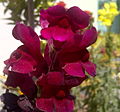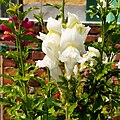Circumscription
The taxonomy of this genus is complex and not yet fully resolved at present. In particular the exact circumscription of the genus, especially the inclusion of the New World species (Saerorhinum), is contentious. [4] The situation is further complicated by the variety of terms in use for infrageneric ranks, especially of the Old World species, that is Antirrhinum, sensu stricto (e.g. Streptosepalum, Kicksiella, Meonantha).
The USDA Plants Database recognises only two species: A. majus (the garden snapdragon), the only species naturalised in North America, and A. bellidifolium (the lilac snapdragon), now considered to be Anarrhinum bellidifolium (L.) Willd. [5] There are 23 accepted species. [6]
A widely accepted scheme (Thompson 1988) placed 36 species in the genus in three sections. While many botanists accepted this broad circumscription ( sensu lato ), whose main departure from other classifications was the inclusion of the New World Saerorhinum, [7] others did not, restricting the genus to the Old World. (For a comparison of Thompson with earlier systems, see Oyama and Baum, Table 1.) New species also continue to be discovered (see e.g. Romo et al., 1995).
In 2004, research into the molecular systematics of this group and related species by Oyama and Baum confirmed that the genus sensu lato as described by Thompson is monophyletic, provided that one species ( A. cyathiferum ) is removed to the separate genus Pseudorontium, and the two species of Mohavea (Mohavea confertiflora and M. breviflora) are included. The species list given here follows these conclusions. [4]
This is the broad circumscription that includes the Old World Misopates and New World Sairocarpus . By contrast the narrow circumscription (sensu stricto) confines the genus to the monophyletic Old World perennial species with a diploid chromosome number of 16, distributed in the Mediterranean basin, approximately 25 species, [8] following the phylogenetic analysis of Vargas et al. (2004) suggesting they are a distinct group. Both Misopates and Sairocarpus are accepted names in The Plant List, and many of the New World species now have Sairocarpus as their accepted name, rather than Antirrhinum. It has been proposed that many of the New World Antirrhinum be now considered under Sairocarpus, in the forthcoming Flora of North America . [9]
Infrageneric subdivision
It is widely agreed that this broad group should be subdivided into three or four subgroups, but the level at which this should be done, and exactly which species should be grouped together, remain unclear. Some authors continue to follow Thompson in using a large genus Antirrhinum, which is then divided into several sections; others treat Thompson's genus as a tribe or subtribe, and divide it into several genera. For a comparison of earlier schemes see Mateu-Andrés and de Paco, Table 1 (2005) [10]
If the broad circumscription is accepted, its three sections as described by Thompson are as follows (two Old World, one New):
- Section Antirrhinum: 19 Old World species of relatively large flowered perennial plants, including the type species Antirrhinum majus , mostly native to the western Mediterranean region with a focus on the Iberian Peninsula. Chromosomes number=8. (3 subsections: Majora, Sicula, Hispanica)
- Section Orontium: two species, also from the Mediterranean. Chromosome n=8. The species in this section, including the section type species Antirrhinum orontium (lesser snapdragon) are often treated in the genus Misopates .
- Section Saerorhinum: 15 small flowered New World species, mostly annual plants and mostly native to California, though species are found from Oregon to Baja California Sur and as far east as Utah. Tetraploid (n=15-16). Like other authors, Thompson placed A. cyathiferum in this section, but Oyama and Baum, following earlier authors, suggest that it should be reclassified in genus Pseudorontium , while Mohavea should be included. Vargas et al., strongly recommending segregation of the New World species suggest that the 14 species originally recognised by Sutton (1988) more properly belong to Sairocarpus (11 species), Howelliella (1 species), and Neogarrhinum (2 species). Other authors would also include Galvezia glabrata , Galvezia juncea , Galvezia rupicola and Galvezia speciosa . [1] None of the names originally allocated to this section are now accepted.




























